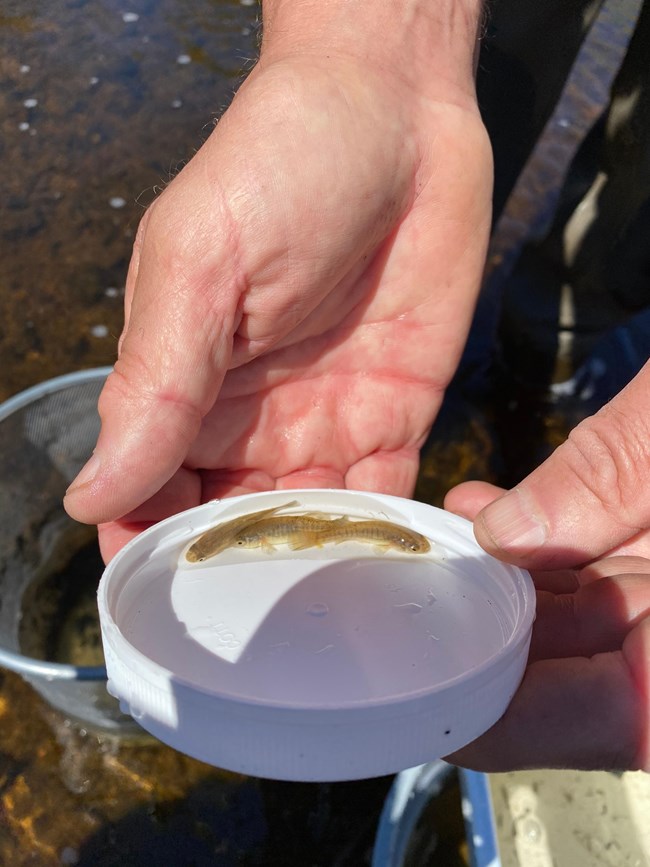Last updated: March 23, 2022
Article
Anadromous Fish

NPS Photo / Saugus Iron Works National Historic Site
Make the journey from salt to freshwater to learn about anadromous fish! This article is a source for information about anadromous fish in the Saugus River. Details include a myriad of species that are born in freshwater estuaries, live their lives in the ocean, and return to freshwater to spawn. Anadromous fish range in size from an average of 10 inches in one species, to 50 inches in another, can be found in the waters tied to the Saugus Iron Works. Learning about these species of fish and how to best protect their habitats will help ensure their preservation by the National Park Service.

NPS Photo / Earl Perez-Foust
What does it mean for a fish to be anadromous? (a-NAD-row-mus)
Anadromous fish migrate from saltwater to freshwater to spawn. They live in the ocean, but in the springtime, they swim up the rivers they were born in to reproduce.
The Saugus River at the Iron Works is a tidal estuary open to the ocean. Saltwater flows in and out of it as far up as the Iron Works with the rise and fall of the tides in Lynn Harbor. Upriver from the Iron Works it is freshwater coming down from Lake Quannapowitt in Wakefield.
What anadromous fish spawn in the Saugus River?
Alewife (Alosa pseudoharengus). Alewives average 10 to 11 inches in size. They come up the river in April and May to spawn in the lakes and ponds on the river. The fry (young fish recently hatched from eggs) spend their first summer in the estuary before migrating out to sea in the fall as 2 to 4 inch juveniles. Adults return to the river they were born in after 3 or 4 years.
Blueback Herring (Alosa aestivalis). Bluebacks average 10 to 11 inches in size. They come up the river in April and May and spawn in the freshwater streams in the watershed. Like the Alewife, the fry spend their first summer in the estuary before migrating to the ocean in the fall.
Rainbow Smelt (Osmerus modax). These smelt average 6 to 8 inches in size. They come up the river from March to May to spawn in the freshwater riffles (a rocky or shallow part of a stream or river with rough water) just upstream of the tidal estuary. Upon hatching, the fry immediately move to the estuary to spend the summer before migrating in the fall.

Wildlife Conservation Society / Southwest Alaska Network.
What challenges do the fish face?
Industrial Pollution: Until recently, industries along the Saugus River dumped their waste in the water. Industrial waste was trapped in the sediments that built up behind the dams. When the dams were breached, much of the contaminated sediment was washed downstream and deposited on the river bottom. Contaminated river sediment remains a threat to animals that live in the river or eat other animals that live in the river.
Highway Runoff: the Saugus River passes twice under I-95, and once under US Route 1. During rainstorms, runoff from the highways enters the watershed carrying brake dust, motor oil, gasoline, rubber dust, brake fluid, engine coolant, exhaust particles, and other debris from the cars and trucks.
Habitat Destruction: In the past, industries dammed the Saugus to provide water to power their machinery. Fish couldn’t get around the dams, so they stopped coming.
What can be done to protect the fish?
Keep the water clean. Industrial dumping hasn’t been allowed since the 1980s, but reducing the amount of chemicals and debris generated by cars on the highways directly affects the water quality.
Be mindful of the chemicals you use around your home. Run off from your yard and driveway gets into the watershed.
Don’t stir up the sediment in the river. That can release trapped waste into the water.
Prevent habitat destruction. Fish need ponds, streams, riffles and rapids to be able to move up and down the river and to lay their eggs. In the late 1800s, industries built fish ladders beside the dams and the fish began to return. In the 1900s, the industries left and the last dams were removed. In 2008, the Park Service built a fish berm just north of the turning basin to provide more spawning grounds. Don’t drain wetlands or build in or near them.
